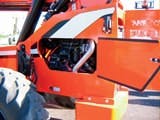There are two camps when it comes to telehandler engine mountings: Those who prefer engines located in pods mounted beside the frame, and others that like engines center- or rear-mounted within the frame.
It is widely believed that the earliest telescopic material handler was the Extendo, produced by Pettibone in about 1969. The Extendo and other early telehandlers were designed with the engine mounted in the frame, which was driven largely by the engine, transmission, and driveline technology of the day. OEMs turned to readily available, tried-and-true tractor technology. This fact drove not only engine placement, but also boom pivot locations. The boom-pivot point was mounted either high above or behind the engine.
European markets demanded more compact and more versatile machines. Concerns about all-around visibility drove them to lower the boom-pivot point, allowing for better visibility on the right-hand side of the unit when the boom was fully lowered. Lowering the boom mandated a revision to the layout and included moving the engine to a location on the side between the wheels.
Machines from Merlo, Manitou, and Caterpillar came to market in the late 1980s and early 1990s. Over-the-boom visibility and the perceived service-access advantages of side-mounted engine designs came at a cost premium if a hydrodynamic drive was used. But according to Dana Spicer, a leading supplier of driveline products to the telehandler industry, the volumes produced today make the cost more manageable.
It is interesting to note that of the 14 machines in the 10,000-pound capacity, 50- to 59-foot lift height class, six have side-mounted engines and eight are mounted in-frame. The eight companies with in-frame engines — Pettibone, Xtreme, ZoomBoom, Lull, SkyTrak, Ingersoll Rand, Gradall, and Genie — all participated in the Telehandler Showcase.
Side-mounted engines are very easy to access. All are located under large swing-up hoods typically made of fiberglass or ABS plastic. We like the fact that these are easy to secure under lock and key, and items like the fuel filter, fluid check points, the battery, and its disconnect are all handy. The only drawback is that some service points, typically the starter, are located on the back side of the engine and require lying on your back and crawling under the engine — something you wouldn't want to do on a muddy jobsite.
Two key advantages of side-mounted engines is that placement of the pod should reduce both engine noise and heat transfer to the operator's cab. Unlike the JLG, Mustang, and Gehl telehandlers, Manitou's pod engine is mounted at right angles to the chassis. The transverse configuration allows equal access to both sides of the engine.
In the in-frame camp, there are two locations being utilized. The SkyTrak, Lull, and Genie telehandlers place the engines more toward the rear of the frame. This is the most traditional location for engine placement. The more recently introduced models from ZoomBoom, Xtreme, Pettibone, and Ingersoll Rand place the engines closer to the middle of the frame. Although service points on the rear engine units are quite adequate, there are some access limitations when compared to the wide-open access offered by the newer mid-engine designs.
Those that adhere to the in-frame engine design claim unique advantages. In-frame engines do not have the additional cost and maintenance associated with the required transfer box between the transmission and the driveline. In-frame marketers argue that the absence of the pod actually improves right-hand side visibility — especially when the boom is elevated to carry position. They also point out that the pod engine could limit maneuverability when attempting to crab up next to a post or beam. Although not really an operator issue, engineers must also deal with keeping the center of gravity along the centerline of the machine. When an engine is mounted on the side, significant counterweight must be added.





